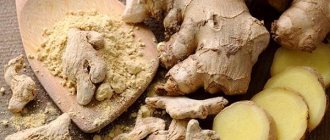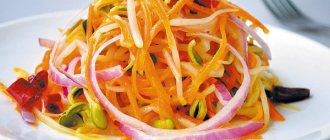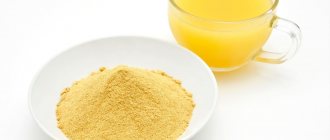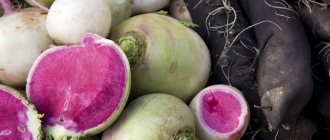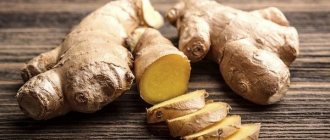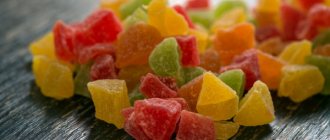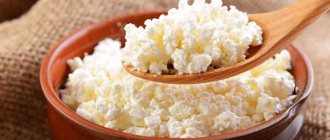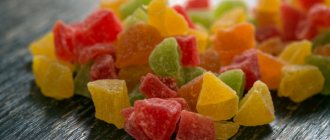In recent years, ginger root has been found on grocery store shelves. This plant is considered medicinal due to its ability to kill harmful microorganisms. Ginger-based products are especially popular during cold and flu season. The root is often used as a spice due to its unusual aroma. Ginger has found application in cosmetology for healthy hair and skin. However, excessive consumption of any product can harm the body, so it is important to follow certain standards.
Description of the plant
Only ginger root, which has a yellow or beige tint, is on sale. Therefore, many people want to know what ginger looks like completely. It is a perennial plant that grows in tropical and subtropical climates. Habitat: South Asia, Australia, India. China is considered the largest exporter of medicinal plants.
Residents of Russia can also plant ginger in their garden plot, however, the plant will need to create favorable conditions. It resembles a trunk up to 1.5 meters high. The inflorescences look like ears of corn. Flowers are yellow, brown, beige. Ginger reproduces by rhizomes. The roots resemble Jerusalem artichoke. To prepare dishes, the roots are cleaned in advance. The inside is juicy and stringy. Ginger attracts with its unusual taste - slightly sweet and spicy.
Fresh and dried roots that have been chopped in advance are suitable for food. Some stores sell pickled ginger, a popular Asian herb. But the most useful are considered to be fresh roots, recently dug out of the ground. They go perfectly with fish and meat dishes. Some people like to drink ginger tea. In European countries, the plant gained fame in the mid-14th century. It got there thanks to sailors. Ginger gained its greatest popularity during the plague. People used the healing properties of the plant to avoid infection. The widespread use of the plant began in the 16th century, when it was introduced to North America.
Use in cooking
Ginger is widely used in cooking. It is especially useful in cold weather and cold climates. It makes food light and easily digestible and gives it a slightly pungent, spicy taste. It is used to make sweets, compote, marmalade and candied fruit. It adds a delicate taste to soups, especially bean and potato soups, including sauces and all types of rice dishes. A slice of such a product can be added to the second dish during cooking and removed before serving. Here, for example, is a recipe for an amazing ginger-tomato sauce.
Ingredients:
- 5 g ground ginger or 1/10 bag of ginger flakes;
- 1.5 kg of tomatoes, cut into 4 parts;
- 1 tbsp. a spoonful of chopped mint or parsley leaves;
- a pinch of ground black pepper;
- salt;
- 1 or 2 tablespoons of vegetable oil.
Place the ginger flakes and tomato slices in a deep, heavy saucepan and simmer, covered, over low heat for 30 minutes. Then remove the ginger flakes, mash the tomatoes into a puree, add salt (you can do without it to reduce calories), pepper, chopped herbs and mix with oil. There are 23 kcal per 100 g of sauce. Bon appetit!
Today, ginger root is not losing its position both in demand and in benefits, only now every person can afford this pleasure and medicine. Take care of yourself!
Useful properties of ginger
The most useful part of the plant is its roots. They are used fresh to treat various diseases. Dried ginger is suitable for cooking. We invite you to find out all the beneficial properties that the plant has:
- Reducing symptoms of nausea (you need to chew ginger);
- Acceleration of metabolic processes;
- Improving the functioning of the digestive organs;
- Prevention of constipation;
- Elimination of bloating;
- Strengthening gums. The infusion is used for rinsing;
- Normalization of blood pressure;
- Strengthening the heart;
- Fighting parasites living in the intestines;
- Memory improvement;
- Elimination of acne;
- Treatment of depression;
- Improving the condition of the skin.
Women
There is evidence that ginger root was considered medicinal several thousand years ago. Its unique properties have been described many times by Chinese folk healers. In addition, ginger received the attention of Hippocrates and Avicenna. Almost all of the above beneficial properties bring equal benefits to the male and female body. However, within the framework of gender, properties for the female gender can be distinguished.
For example, it is advisable for women to consume ginger during menstruation. The plant contains substances that reduce pain. Ginger has been used for centuries to treat infertility. The peeled root helps relieve nausea during pregnancy. It is worth noting that this healing property is observed only in the 1st trimester of pregnancy. At a later date, it is better to abandon the product. The reason for this is its ability to lower blood pressure. In general, ginger is beneficial for the female body, especially for the uterus.
Ginger is a natural aphrodisiac. It is able to increase sexual desire by improving blood supply to the pelvic organs. The dietary qualities of the product are also known. Yellow root improves metabolic processes in the body. Helps remove toxic substances and burn fat. This is the reason why ginger is added to many diets.
For men
In Chinese, the word "ginger" is equivalent to "masculinity." The plant fully lives up to its name, as it brings great benefits to the body. It has a positive effect on all internal organs. Golden root is considered a masculine spice and has been known in China for thousands of years as an aphrodisiac. The composition contains vitamin C and lysine, which increases potency. There are substances that improve blood supply to the genital organs. The healing plant can relieve inflammation and reduce the likelihood of developing prostatitis. Ginger is used in the treatment of infertility. The immune system-boosting properties of ginger cannot be underestimated. An additional benefit is improved memory.
In cosmetology
The plant is often used in cosmetology. It can improve the condition of the skin and hair. Ginger has been added to cosmetics for centuries. Today, many manufacturers use it to make masks and shampoos. Some people prefer to rub the juice squeezed from the root into their heads. Thanks to the unique composition of this substance, hair becomes stronger and healthier. Ginger is considered an antioxidant, so regular use of the plant removes accumulated toxins and radicals from the body. As a result, skin cells are restored. For various skin diseases (for example, acne), it is recommended to use plant derivatives. In pharmacies you can find ginger-based products that have antiseptic properties. These products are used to treat the surface of the skin to get rid of acne.
Benefit for health
Thanks to its rich vitamin composition, ginger is beneficial for men and women:
- The most notable beneficial property of the product is its beneficial effect on the digestive system. Eliminates various disorders, flatulence, nausea.
- Drinking ginger tea during pregnancy eliminates morning sickness in the first trimester.
- Ginger tea, drunk before a trip, will ease seasickness and reduce nausea from motion sickness in transport.
- Systematic consumption of drinks with ginger or the product on its own improves the condition of teeth and relieves inflammation of the gums.
- The product has a positive effect on the functioning of the cardiovascular system, normalizes blood pressure, improves blood flow to the brain, normalizes the heartbeat, and strengthens the heart muscle.
- Adding ginger to food at least a couple of times a week or drinking drinks with the product eliminates irritability and calms the nervous system.
- The product has anthelmintic properties.
- Ginger root added to tea stabilizes the intestines, providing a mild laxative effect (especially useful for older people).
- Systematic consumption of the product accelerates metabolism and reduces cholesterol levels in the blood.
- Including the product in the diet has a positive effect on the functioning of the male genital organs, increasing desire and potency. Systematic consumption of ginger reduces the risk of inflammatory processes in the prostate.
Ginger oil helps eliminate psycho-emotional problems (you can use it for massages or simply inhale the smell). Ginger root improves mood and helps keep muscles toned.
© genjok — stock.adobe.com
Harmful properties of ginger
Despite the above qualities, ginger is not suitable for some people. Almost all medications have contraindications. Yellow root is no exception. We invite you to find out the dangerous properties that may appear after consuming the root.
Particular caution should be exercised if you have heart or blood vessel diseases. If your blood pressure is high, doctors do not recommend using ginger root. The reason for this is blood thinning. If you take medications at the same time, your blood pressure may drop significantly. For stage 1 hypertension, the medicinal plant can reduce blood pressure. It is important to exercise caution. People who have had a heart attack or stroke should avoid the plant. When choosing products, you need to carefully study the composition for the presence of ginger.
The yellow root is known for its pungent taste. It can irritate the gastric mucosa. Therefore, if you have a disease of the digestive system, you should discard the product. These include the following diseases - ulcers, gastritis, colitis. The same reason for contraindications occurs when the oral mucosa is damaged. Liver and kidney diseases are considered a reason to stop consuming ginger. The root should not be given to children under 2 years of age. After 2 years, it is recommended to introduce the product gradually, otherwise allergies may develop.
Let us remind you that pregnant women are allowed to consume the plant only in the 1st trimester in order to reduce the effects of toxicosis. In the 2nd and 3rd trimester, ginger begins to be dangerous for the fetus and mother, as it greatly lowers blood pressure.
Many people are used to treating colds with ginger root. However, at high body temperatures, the plant may be unnecessary - it causes a feeling of intense heat. An additional contraindication is bleeding from hemorrhoids.
There is widespread advice to use ginger for diabetes. However, the plant cannot be combined with antidiabetic drugs. Also, the plant does not combine with medications against arrhythmia and high blood pressure. If you eat too much of the product, unpleasant consequences will occur. First of all, from the intestinal tract. Nausea, diarrhea, and vomiting are observed. The use of the plant must be stopped immediately.
Contraindications and harm
If you have an allergy or individual intolerance, ginger can harm the body.
Who is contraindicated for ginger:
- pregnant women in the third trimester - it can cause premature birth;
- people who regularly take medications to regulate blood pressure or blood sugar levels, since ginger root has the same effect on the body;
- those suffering from cholelithiasis, as well as people with frequent edema.
Since ginger affects the acceleration of blood circulation, people suffering from chronic bleeding should avoid it.
It is not recommended to drink ginger tea before bed, as it can increase body temperature, and it is not advisable to exceed the specified daily intake. People suffering from inflammatory processes in the gastrointestinal tract should avoid ginger in any form.
People who have not tried the product before should not immediately go on ginger diets. First, you need to eat a small portion or drink a ginger drink to check the body for allergies or individual susceptibility to the product, and only then increase the dose of consumption.
© Luis Echeverri Urrea — stock.adobe.com
How to choose the right ginger
Today the plant is sold in several states.
You can find dried, pickled and fresh roots on supermarket shelves. They are used for different purposes. For example, the dried root is considered a spice. It is added to soups and other dishes. When choosing a product, you need to carefully examine its surface. There should be no signs of mold. If the ginger is ground, you need to check the structure of the powder. The presence of lumps, which are a sign of moisture ingress, is unacceptable. Fresh roots are better suited for medicinal purposes. In supermarkets, such products are quickly snapped up by customers. It is recommended to buy young roots that contain high nutrients and juice. A distinctive feature is a smooth surface, absence of damage, dense structure. Fresh ginger provides the most benefits.
The third variety is considered to be marinade. Ginger is poured with water and rolled into glass jars. The canned product is suitable for disease prevention. It retains many useful substances, microelements and vitamins. Long-term storage is considered an additional advantage. The marinade can be refrigerated for several months. The main thing is to remember the expiration date indicated on the packaging. If the ginger was imported from distant eastern countries, this option is considered better. On the road, the canned product does not spoil, unlike fresh or dried roots.
Selection rules
The root can be found on sale in several forms: fresh, dried and pickled - different storage methods for different purposes. The dried root is well suited for use as a spice. When choosing a dried product, you need to inspect its surface for fogging and mold - of course there should be none. There should be no lumps in the ground product.
For medicinal purposes, it is best to choose fresh roots. Products often remain stale on supermarket shelves. If storage conditions are violated, the root becomes dry, wrinkled or begins to rot. Choose heavier roots, hard and dense, they contain more juice. The benefits of fresh foods are always, undoubtedly, higher than dried or pickled ones.
The marinade is equally suitable for preparing dishes and for preventing diseases. It is slightly worse than fresh root, and still retains many active trace elements and nutrients. Storing marinade is easier than dry product and its shelf life is much longer. If ginger is imported from distant hot countries, then the pickled version will be of higher quality than the dried one.
Proper storage
There are several ways you can store ginger at home. For example, it is better to place fresh roots in the refrigerator, first tightly wrapping them in cling film. Polyethylene film prevents moisture evaporation and roots drying out. The shelf life of ginger reaches 2 weeks. It can be frozen in the freezer. Before this, the roots should first be peeled. Then cut it into small slices with a knife for ease of use.
There is an additional option - dry the plant and wrap it in thick paper. Then the shelf life will be up to 1 month. The ideal place for storage would be a cool room. Dried roots are placed in small fabric bags and kept at room temperature for one and a half years.
You can grate the root or finely chop it. Then dry it at 50 degrees in the oven. Determining readiness is quite simple. You need to feel the surface of the product. The finished plates can be easily broken into pieces. The product is placed in a glass jar and stored for several years.
There is a way to make homemade ginger marinade. Finely chopped or grated plant is poured with liquid bee honey. This combination enhances the healing properties of the root. Storage duration is up to 6 months.
If there is a lot of fresh ginger, it is recommended to make natural juice using an electric juicer. It is not advisable to drink pure juice; it can harm the gastric mucosa. It is much better to prepare an alcohol tincture. To do this, 1 part juice is diluted in 1 part alcohol. The finished liquid is sealed in a glass jar and infused. The shelf life is 3 years. After opening the jar, the contents must be consumed within 21 days. The rest is to be poured out. This tincture cannot be drunk in its pure form. It is added to a variety of drinks, for example, milk, tea, fruit juice. It is important that the drink is not hot. The tincture is used to treat colds.
What does this plant help with and what does it cure?
Ancient Eastern medicine widely used ginger in the treatment of diseases. The most widespread are recipes for preparing ginger for colds, poisoning, general strengthening and used in cosmetology. It’s worth dwelling on the medicinal properties of ginger, their real effectiveness and contraindications.
For gastritis
Regular use of the white tuber irritates the mucous membranes of the digestive organs. If a person does not suffer from inflammatory diseases of the stomach and intestines (gastritis or ulcers), then stimulation with ginger seasoning is a good prevention of gastric diseases. But nothing more.
If inflammation in the form of gastritis already exists, then in damaged areas of the mucosa, spicy food will provoke an expansion of the affected area and a deterioration in the regeneration of intestinal epithelial cells.
A person suffering from gastritis is prohibited from eating too fatty, fried and spicy foods. This means that gastritis and stomach ulcers are contraindications to the use of ginger. At the same time, doctors do not see the danger of ginger for the stomach when consumed in moderation during remissions. That is, it is impossible to treat gastritis with ginger, but moderate use is allowed in mild forms of the disease and in the absence of other contraindications.
Against cancer
In the vast media space there are many recipes for “anti-cancer” ginger. The desire of people to get rid of this terrible disease by any means is understandable, but it has not been scientifically confirmed.
There are cautious assumptions from doctors about the preventive effect of the spice, but hypotheses cannot replace many years of research conducted within the framework of evidence-based medicine. Ginger cannot be considered a cure for cancer, despite the claims of “naturopaths” that it “cures better than chemotherapy.”
Clinical experience shows that attempts to cure cancer using unconventional methods end with the tumor progressing to incurable stages. Although a tumor is not a contraindication to the use of ginger.
In cosmetology
One of the beneficial properties that is beyond doubt is the use of ginger in cosmetology. The substances and essential oil contained in the tuber help rejuvenate the skin, nourish and gently cleanse it. Ginger face masks have the following properties:
- smooth out wrinkles;
- refresh and improve complexion;
- restore skin firmness and elasticity;
- cleanse, help get rid of acne;
- stimulate epithelial blood flow;
- heal wounds and cracks;
- regenerate (renew) and tone the skin;
- destroy harmful microflora on the skin;
- prevent its aging.
All this can be achieved thanks to the antioxidant, tonic and rejuvenating effect of ginger masks. Their peculiarity is that they are universal, that is, they are suitable for any skin type and have almost no contraindications.
Here are some tips on how to use ginger to make masks:
- Mix 20 g of grated ginger, 15 ml of chamomile decoction (1 tablespoon per 200 ml of boiling water), 10 ml of green tea and 20 g of white pharmaceutical clay.
- Combine 5 g of grated ginger, 5 ml of lemon juice, 20 ml of green tea and 20 g of green clay.
- Mix pomegranate juice (15 ml) and grated ginger (40 g) and lubricate the skin.
- Add a pinch of dried ginger to 40 g of liquid honey, lubricate the skin and leave for 15 minutes.
The general rules for using masks are known to most women:
- Apply the mask mixture not only to the face, but also to the neck and décolleté;
- masks should not be kept on the face for more than 20 minutes, much less leave ginger on the skin overnight;
- It is better to wash them off with warm water.
You can check if you have any contraindications to the components of the mask: lubricate the most delicate part of your hand - the wrist or elbow, leave for 20 minutes, remove. If obvious signs of an allergy do not appear within 24 hours - rashes, itching, etc., then you have no contraindications to its use.
In case of poisoning
When there is no activated carbon or other sorbents in your home medicine cabinet, you can use ginger for poisoning if there are no contraindications.
The spice has a pronounced antiemetic property; it increases the acidity of gastric juice and speeds up the digestive process. We'll tell you how to prepare ginger in the form of tea, which you can drink if there are obvious signs of poisoning, if there are no contraindications:
- To prepare the drink, boil 200 ml of water.
- Pour into a tea cup, where grated ginger (a teaspoon) is added.
- Cover the cup with a saucer and let it brew for 5 minutes.
A similar drink can be prepared with strong brewed green tea using the same amount of ginger chips.
When turning to any folk recipes for help, do not forget that if there is no effect and your health worsens (especially in case of poisoning), you must urgently call a doctor.
Ginger tea should not be used by those who have contraindications to its use. You can get problems even from such a healthy spice as ginger. The benefits and harms of any product depend on the ability to use it and compliance with contraindications.
For a cold
In no other area are the beneficial properties of ginger so popular as in the treatment of colds in the absence of contraindications. The components included in its composition have all the useful properties necessary for this:
- disinfectant and antiseptic;
- mild pain reliever;
- warming (which is important for hypothermia);
- anti-inflammatory and diaphoretic;
- antispasmodic (this is necessary for the stomach, which often “resists” the treatment of colds);
- tonic, which will help quickly restore strength spent on illness.
The beneficial properties of ginger tea will ease the course of the disease, ensure enhanced metabolism and rapid evacuation of pathogen decay products from the body.
For diabetes
Are there any other beneficial properties of ginger, what else does ginger cure? And is it possible to use ginger if you have diabetes? According to endocrinologists, this issue can only be considered in relation to type 2 diabetes, since in type 1, experiments with herbal medicine can end badly.
But for type 2 diabetics there are several contraindications in which the use of ginger tuber is prohibited:
- if the patient is taking antihyperglycemic drugs;
- if the disease is not compensated by following a special diet and regular physical activity.
Beneficial features:
- thanks to gingerol, the ability of myocytes (muscle cells) to absorb glucose without the help of insulin increases;
- the use of seasoning slows down the development of cataracts (a dangerous ophthalmological complication in diabetes);
- Ginger root has a fairly low glycemic index, so sharp jumps in glycemia cannot be expected from it.
We offer a couple of ways to prepare ginger for diabetes:
- Peel a piece of fresh tuber and soak in cold water for an hour. Grate, put the raw material in a liter thermos and fill with boiling water. This tea can be mixed with green or black and drunk half an hour before meals 3 times a day, if there are no other contraindications.
- Prepare the rhizome as described above, grate it and place the shavings in a piece of gauze folded in half. Squeeze out the juice and place it in a dark place. You can drink it no more than 2 times a day and no more than 12 drops, if there are no contraindications.
The procedure of soaking the root in cold water is necessary in order to reduce the toxic effect of chemicals used during storage of the product (there are especially many of them in tubers from China).
For immunity
Strengthening the immune system is a priority task for both doctors and patients during the epidemiological period. As for the ginger tuber, the benefits of its use in the absence of contraindications are increasingly confirmed by medical practice and observations of the patients themselves.
The use of ginger as an immunostimulant is justified if only because it does not violate the main rule - do no harm. Of course, provided that the spice is used taking into account contraindications, not in “shock” doses and not instead of medications prescribed by a doctor.
Recipes with ginger, lemon and honey are especially popular. You can learn how to prepare immune-healthy drinks from these products, taking into account contraindications, from the article.
Does it lower or increase blood pressure?
Among the list of beneficial properties of ginger is the ability to prevent the development of atherosclerosis. This happens due to stimulation of the stomach, intestines, digestive glands, as well as stimulation of the nervous system. It would seem that cholesterol has no reason to linger on the walls of blood vessels in which blood flows like a river. But it's not that simple.
Due to the increase in the general tone of the body, physical activity, mobility and cardiac output increase, which means systolic pressure increases. This spice cannot offer mechanisms for lowering blood pressure.
That is why arterial hypertension, coronary artery disease, and angina are contraindications for consuming the root.
How to eat ginger
The roots have a pleasant smell and pungent taste. Ginger has a refreshing effect.
Before eating ginger, you need to wash it, peel it and soak it in cold water for 1 hour. Pre-soaking will get rid of chemicals and fertilizer particles that were contained in the soil.
You can find many ways to prepare ginger on the Internet.
- 1 tablespoon of grated root is equal to 1 teaspoon of powder. Usually 1 gram of spice is added to 1 kilogram of dish.
- To prepare ginger tea, take a small part of the root (the size of the phalanx of the little finger), grate it or finely chop it with a knife. Then pour 1 glass of hot water. Add 2 or 3 lemon slices. Cover and leave to steep for a few minutes. If desired, add bee honey or sugar.
- There is a second option for preparing the drink. Take a small part of the root (2 or 3 centimeters) and finely chop it. Add a mint branch, chopped quince, cloves, cinnamon and 3 tablespoons of green tea. The resulting mixture is poured with 0.5 liters of hot water. The liquid is infused for 10 minutes. Then add honey.
Ginger drinks help reduce inflammation and have a calming effect on the nervous system. You can use the healing root in any form.
- Pickled ginger. Pickling the root yourself is quite difficult - it will take a lot of time. Don't forget to stock up on apple cider vinegar. First wash the ginger under running water and remove the peel. Rub the surface thoroughly with salt and place in the refrigerator for 4 hours. Wash again and rinse with boiling water. When the roots have cooled, grate them on a small grater and pour the marinade over them. The composition of the marinade is salt, vinegar, sugar. To make the marinade pink, add grated beets. Leave to infuse for 3 days. The ginger will be ready to use. It is usually served with Asian dishes.
- If you want to make a natural substitute for sweets, prepare candied ginger. They have the only drawback - high sugar content.
- You can also add ginger to cookies.
The dried powder serves as an excellent spice for fish and meat dishes. Ginger is added to sauces, jams and compotes.
Calorie content of ginger and composition
Ginger is a low-calorie product with a rich composition of micro- and macroelements, vitamins, essential and non-essential amino acids. The calorie content of fresh ginger root is 79.8 kcal per 100 g.
After processing, the energy value of the product changes, namely:
- dried (ground) ginger root – 346.1 kcal;
- pink pickled – 51.2 kcal;
- candied fruits (ginger in sugar) – 330.2 kcal;
- tea with ginger (green or black) without sugar – 6.2 kcal.
Nutritional value of the product per 100 g:
- carbohydrates – 15.8 g;
- proteins – 1.83 g;
- fats – 0.74 g;
- ash – 0.78 g;
- dietary fiber – 2.1 g;
- water – 78.88 g.
The ratio of BZH ginger root per 100 g is 1:0.4:8.7, and pickled ginger root is 1:1.1:10.8, respectively.
The chemical composition of ginger per 100 g is presented in the table:
| Name of substances | Unit | Contents of the product |
| Copper | mg | 0,23 |
| Iron | mg | 0,6 |
| Zinc | mg | 0,34 |
| Manganese | mg | 0,023 |
| Selenium | mcg | 0,7 |
| Potassium | mg | 414,5 |
| Magnesium | mg | 43,1 |
| Calcium | mg | 42,8 |
| Phosphorus | mg | 33,9 |
| Sodium | mg | 14,1 |
| Thiamine | mg | 0,03 |
| Kholin | mg | 28,7 |
| Ascorbic acid | mg | 5 |
| Vitamin PP | mg | 0,75 |
| Vitamin E | mg | 0,26 |
| Vitamin B6 | mg | 0,17 |
| Vitamin K | mcg | 0,1 |
| Vitamin B5 | mg | 0,204 |
| Vitamin B2 | mg | 0,034 |
The product contains disaccharides in an amount of 1.7 g per 100 g, as well as poly- and monounsaturated acids, in particular linoleic (0.14 g), omega-9 (0.102 g), omega-3 (0.03 g ) and omega-6 (0.13 g).
The use of ginger in cosmetology
Many pharmacies and stores sell products made from ginger root. For example, hair masks, various oils and shampoos. Typically, the products listed are intended for normal to oily hair. The plant contains an abundance of useful elements that have a beneficial effect on the hair follicles and scalp. They get rid of dandruff, increase blood circulation, and have a general strengthening effect.
The plant is often added to gels and creams, as it stimulates metabolic processes in the body. Another advantage is improved blood circulation. Extracts are very popular - they are used to make facial skin care products. Ginger has pronounced anti-inflammatory properties, which are good for acne. The products are suitable for different skin types. The root contains substances that eliminate age spots.
Ginger extract has a tonic effect. It gives your facial skin a healthy look. It also has antifungal properties, thanks to which it is used to make foot creams.
Thus, the plant can be called a universal remedy for beauty and health. The next time you go to the grocery store, don't pass by ginger roots. Buy a healthy product - you can add it to various dishes or prepare drinks based on it. The healing root helps maintain health and resist various diseases.
Ginger diet
One of the simplest and easiest diets in the world is ginger! You just need to eat deliciously, adding ginger to all dishes, even tea. Doubt the result? Then a detailed explanation is presented to your attention.
The main problem of many losing weight is improper metabolism and energy. With an incorrect, unbalanced diet, a person’s metabolic processes are disrupted, which leads to sudden obesity, and many harmful and toxic substances cannot be eliminated naturally for this very reason. And adding ginger to your daily diet leads to stabilization of metabolism, which promotes weight loss.
The main advantage of this diet is that you do not need to adhere to a specific menu. Each of us can independently create a daily diet for ourselves, taking into account our tastes and preferences, but not forgetting about a balanced diet. So, to achieve results in losing weight with the help of ginger, it is necessary to reduce the overall intake of calories, that is, cut down on the consumption of flour, fried, spicy, sweet, alcohol, and add ginger tea and candied fruits to the diet. It's simple!
How else can you cook?
There are so many recipes for making ginger drinks that it’s impossible to tell about them all. For lovers of hot drinks, we offer the option of ginger-fruit tea with orange:
- Brew any tea to your taste.
- Add grated or powdered cinnamon to the kettle to taste.
- Add a few cloves and finely grated ginger and let the tea brew.
- Meanwhile, cut 2 slices each of red apples, oranges and limes into tea glasses.
- Sprinkle the fruit with vanilla, place a sprig of mint on top and pour tea to the brim. If desired, you can add honey.
Children adore this drink and drink it through a straw, then top it up with a fresh portion of tea and continue the pleasure.
If you are going to treat your guests to this drink (and it is worth it), do not forget about the contraindications.
What is this root eaten with?
The spicy ginger tuber is eaten with different dishes depending on the preparation of the root itself:
- marinated is served with dishes of fish, seafood, vegetables, cereals and meat;
- candied is eaten as a snack with tea and other drinks;
- dried ground is added to teas and drinks, as well as sauces, marinades, first and second courses and desserts.
It is difficult to say what fresh ginger is eaten with, perhaps with nothing, because this tuber is neither a vegetable nor a fruit. But you can squeeze juice out of it to add to teas and dishes, or prepare it in any other way, if there are no contraindications.
